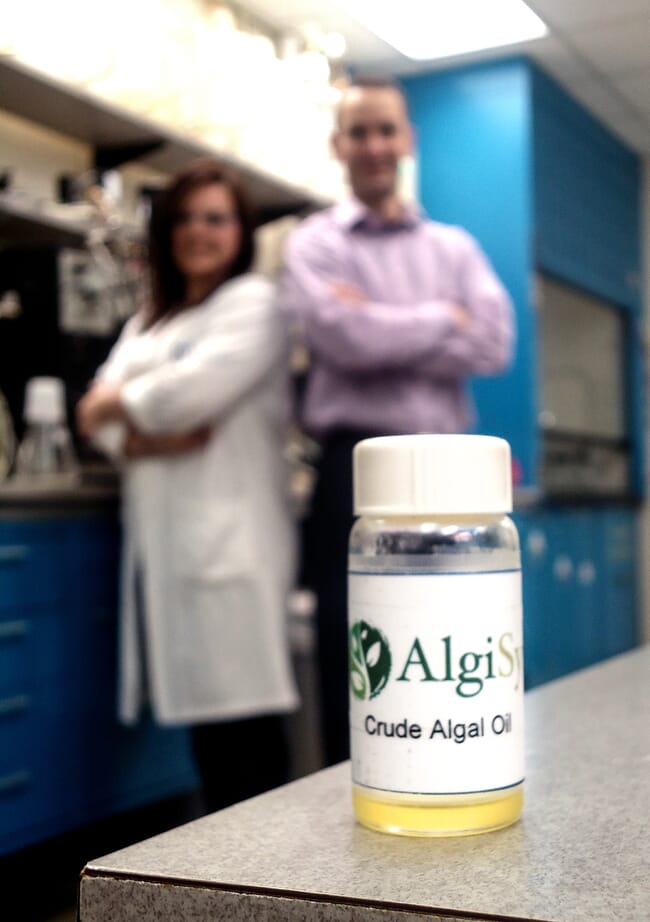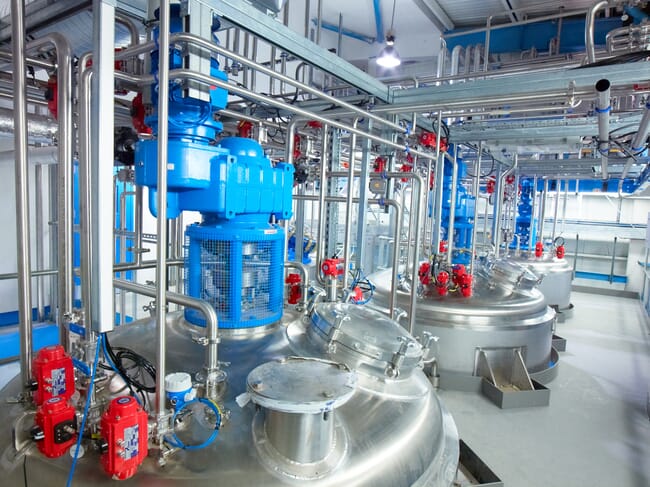
Dr Rowe's work with algae spans several decades and includes research into omega-3s, alternative protein and other bioproducts © AlgiSys
The startup was founded in 2009 by Dr Charles Roe, a chemical engineer with experience at multinational companies including General Electric and ICI.
“After my time at large corporations, I was recruited by a group of Procter and Gamble executives to start a global consulting company focused on open innovation and, ultimately, began to do some consulting in the algae and biotech spaces, before leaving to start AlgiSys,” explains Dr Roe.
He was impressed by the huge range of algal species and the products that could be made from algae for various markets.
“Simply put, we've identified some novel strains of microalgae which, when we ferment them, produce EPA [the long-chain omega-3 fatty acid] and protein. One particular strain is an ideal feed ingredient for use in salmon aquaculture, shrimp farming and other applications as well,” he explains.
“If you look at the history of algae as a commercial product, all of the initial funding and effort mostly went into biofuels, which didn’t produce the kind of return on investment sought by investors. Dr Roe and our team took a step back and looked more broadly at the higher value applications. And we identified EPA omega-3, with its multiple vertical markets and the disruptive potential to replace fish oil,” adds Roger Frank, the CEO of the company’s aquaculture division.
While other companies sell refined algal oils, AlgiSys prefers to dry their algae and make an EPA-rich omega-3 powder, which also contains protein, as their initial feed product.
“The reason we're not going to initially extract the oil is because that step adds additional cost. Also, the EPA is naturally encapsulated in the microalgae, so why pull it out of a protected environment formulated by nature and have to add additional antioxidant to protect the EPA? By selling the powder, feed manufacturers also get the benefit of the plant-based protein. Oil extraction can come later,” Dr Roe points out.
“Our product is sustainable, non-GMO, and cyclical. Our goal is to ultimately be a replacement for both fish oil and fishmeal, produced cost effectively, at scale, through fermentation,” adds Frank.
EPA: the alpha omega
While fish oil contains EPA and DHA omega-3s – which are both widely known to be among the most beneficial omega-3s from a health perspective – the AlgiSys team are keen to differentiate between the two.
“EPA is what we consider the most important omega-3 – it affects heart health, joint health, anti-inflammatory responses, brain functions, skin health and more. EPA also converts to DHA in Atlantic salmon, as research has proven, so with our one ingredient you're really getting the nutritional benefits of EPA, DHA and protein. We are a disruptive three-in-one aquafeed ingredient,” Frank observes.
However, he points out the other key omega-3, DHA, which is what most of AlgiSys’ competitors are mainly producing, can’t easily be retro-converted back to EPA, making the AlgiSys product even more valuable.
“For now, as far as we know – and this has been confirmed by external customers and researchers – we're the only known single source of EPA combined with protein. We have patents in six countries, many trade secrets and have proprietary strains – providing a substantial IP moat around our technology,” Frank reflects.
Growing the team
After 15 years and $12 million in cumulative investment, AlgiSys is now commercialising its technology, thanks to the growth of the executive team, which is tasked with the remaining commercialisation and go-to-market work.
“Dr Roe did an extraordinary job finding the right strains of algae from millions of options, but for the first 10+ years we were a bit of a research and development company,” Frank reflects.
As well as the addition of Frank, who brings experience in microfinance and investment banking on Wall Street, the team has brought onboard Pete Colella, who has spent 35 years running startups and operating various companies, as group CEO of AlgiSys BioSciences; and Patricia Barclay, a globally experienced life science attorney with over 30 years working with companies such as Pfizer and the Ferring Group, as well as startups. All bring experience in building companies and monetising technology.

With their first product focused on aquaculture, AlgiSys has decided decided not the refine their algae at this point, as the protein content is also a valuable ingredient for aquafeeds © AlgiSys
Choosing a location
Despite most of their board being based in the US, AlgiSys is basing its operations in Scotland, due in part to the UK government’s pro-biotech stance, combined with Scotland’s commitment to sustainability and its substantial salmon farming industry, which is the third largest in the world.
“We have found a much greater awareness of the importance of healthy ingredients and sustainability in the UK. For example, if you look at the back of the packages of salmon sold in UK retailers, it details the exact amount of both DHA and EPA in the salmon. This is exactly what our ingredient supports, as more omega-3s means better health for the salmon and ultimately the people who eat that salmon,” Frank explains.
“I see the UK as one of the top places for biotechnology in the world. In fact, fermenting microorganisms to produce fatty acids such as arachidonic acid, which is used in infant nutrition, was pioneered at the University of Hull. Out of that technology came fermenting microalgae to make DHA. And now that we've seen commercial success in making DHA from algae, AlgiSys is capitalising on the trend and fermenting microalgae to make EPA and protein,” Dr Roe adds.
“On top of that you have a multi-billion pound aquaculture industry in Scotland along with this wonderful ecosystem that can take in new technologies like ours and make use of them,” he continues.
As a result, AlgiSys elected to set up their main offices at the Roslin Innovation Centre in Edinburgh, where they are also establishing a relationship with Edinburgh Napier University. In parallel, they are working with the Centre for Process Innovation (CPI) in Middlesbrough – which also fermented some of the first batches of Calysta’s FeedKind microbial protein – to actually produce their algae at pilot and commercial scales. Additionally, AlgiSys was recently accepted into Hatch Blue's Crest programme, one of the world's leading accelerators focused on ocean technology, aquaculture and the blue carbon sectors.

The facility also fermented some of the first batches of Calysta’s FeedKind microbial protein © AlgiSys
Milestones
In terms of achievements to date, Frank believes that pioneering their initial product is an important accomplishment.
“Our number one milestone is developing the technology to the point of an initial product for aquafeed. We have met with potential customers and informed industry sources who have stated outright that they have not seen an ingredient like ours whose EPA content is in excess of current sources of marine oil that they're purchasing. Interest in our product is keen, which the market has confirmed,” he emphasises.
The startup is looking forward to the first aquaculture feeding trials using their product.
“Stirling University is one of our major partners for feeding trials, which will start sometime this year. And when we're over in Norway this month as part of the Crest programme, we will also be connecting with some of the other big players in the aquaculture industry,” notes Dr Roe.
Despite progress, they are well aware of the challenges that remain.
“Raising funds is the big one. Then, as we scale, meeting certain price points is important, as are containing costs, being efficient and being sustainable,” Roe points out.
Indeed, given that they are trying to reduce pressure on wild fish stocks, AlgiSys takes its sustainability credentials seriously.
“Hatch and Blue Food Performance are helping us to do a life cycle assessment (LCA), because we want to hit as many of the UN's sustainable development goals (SDGs) as possible. So there's the sustainability piece, the cost piece, the scale up component and then demonstrating the efficacy and value proposition. I think those are the main challenges that any novel ingredient company is going to face,” notes Dr Roe.
They also hint that their sustainability credentials are likely to allow them to command a higher price than fish oils.
“The sustainability aspect of what we're doing is pretty critical. As a premium ingredient, I don't think we're going to compete head-to-head with fish oil on price, unless there's another closure of the Peruvian anchovy fisheries as in 2023, but we’re comparing ourselves to DHA products already being profitably sold in the aquafeed market,” explains Dr Roe.
However, Frank believes that farmers feeding their microalgae ingredient to fish will still reap the rewards.
“We are an alternative ingredient that improves the health of salmon and the people who eat that salmon. It's about reducing mortality and improving nutritional content. Fundamentally, we’re helping to sustainably improve the economics of the salmon aquaculture industry, plain and simple,” he argues.
Plans to expand
The company is currently raising $5 million and expects the first commercial batches of their algal powder to be available within nine to twelve months of funding.
As Roe reflects: “Getting to successively larger fermentation vessels and moving into manufacturing – that's the ultimate goal. We have a four-phase commercialisation plan. Phases one and two are almost complete. Once we finish phases three and four, then we will be transferring to manufacturing at a fermentation facility. We're currently talking with some contract manufacturers and potential strategic partners already to lay the groundwork for that.”
Looking further ahead, their plans include running their own production facility.
“If we were to dream a little about what the future might hold, it would be good to acquire or build our own plant, and Scotland could be a great place to construct a facility. We have the talent in our company to help us design, build, commission and operate a fermentation facility of our own, given the manufacturing expertise of our new team. We anticipate having a lot of options once we start producing at scale and officially launch our initial feed ingredient into the aquaculture markets. The future looks quite bright for AlgiSys,” Dr Roe concludes.




